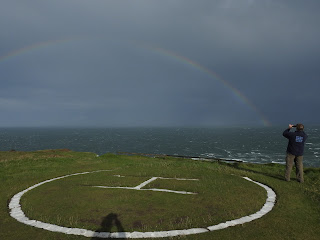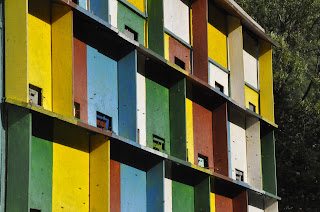I spent a morning walking in the mountains of Rila National Park and I was lucky to have two amazing wildlife encounters.
Up in the mountains I decided to follow a faint vehicle track. As I headed over
the brow of hill I spotted a fox, Vulpes vulpes sniffing around. He circled around and then
started making his way across the hillside. Fortunately for me the wind was
blowing in my direction not his, so I had plenty of time to video him before my
red top caught his eye and he stopped to turn and look at me before
disappearing from my view. It was truly spectacular and made my day.
A little further down the track I was following, I came across a dead and half buried Souslik – I wondered if it was one of his stash?
My other amazing wildlife encounter was a live souslik, Spermophilus citellus, also known as the European ground squirrel and is a similar to but smaller and slimmer than an Alpine marmot. There was one just by the lake at Belkemen and it was both inquisitive but also a bit flighty at first. Eventually I managed to get closer to it and it tried the staying still trick which was fine by me as I snapped away some photos. Eventually he lost his nerve as I moved even closer and bolted down his burrow.
Higher up in the mountains I saw many more of these gorgeous little furry creatures running around but as soon as you got too close they bolted down their holes.
A little further down the track I was following, I came across a dead and half buried Souslik – I wondered if it was one of his stash?
My other amazing wildlife encounter was a live souslik, Spermophilus citellus, also known as the European ground squirrel and is a similar to but smaller and slimmer than an Alpine marmot. There was one just by the lake at Belkemen and it was both inquisitive but also a bit flighty at first. Eventually I managed to get closer to it and it tried the staying still trick which was fine by me as I snapped away some photos. Eventually he lost his nerve as I moved even closer and bolted down his burrow.
Higher up in the mountains I saw many more of these gorgeous little furry creatures running around but as soon as you got too close they bolted down their holes.
I spent the rest of my walk just enjoying the surrounding beauty
of the mountains and the stunning variety of wildflowers. Our journey through the rural parts of Bulgaria took
us to some vast meadows, which are just stunning swathes of colour, blue,
purple, red, orange, white, green, yellow – you can’t really describe all the
shades.
The abundance of wild thyme is also amazing and the scent hits you more than the sight of it. The locals told me to make some tea with it and eventually we did with lemon thyme but that is another story....
The abundance of wild thyme is also amazing and the scent hits you more than the sight of it. The locals told me to make some tea with it and eventually we did with lemon thyme but that is another story....
In other parts of Bulgaria we have ridden along ancient
tracks, one which was quite hard to follow as it was so overgrown with flowers.
The bikes were almost hidden in the height of the wildflowers but there was a
definite stone track beneath.
I have been truly astounded by the beauty of Bulgaria. It
pays to get off the beaten track and explore where the dirt roads and logging
tracks take you and you will be amazed by what you find.

























































